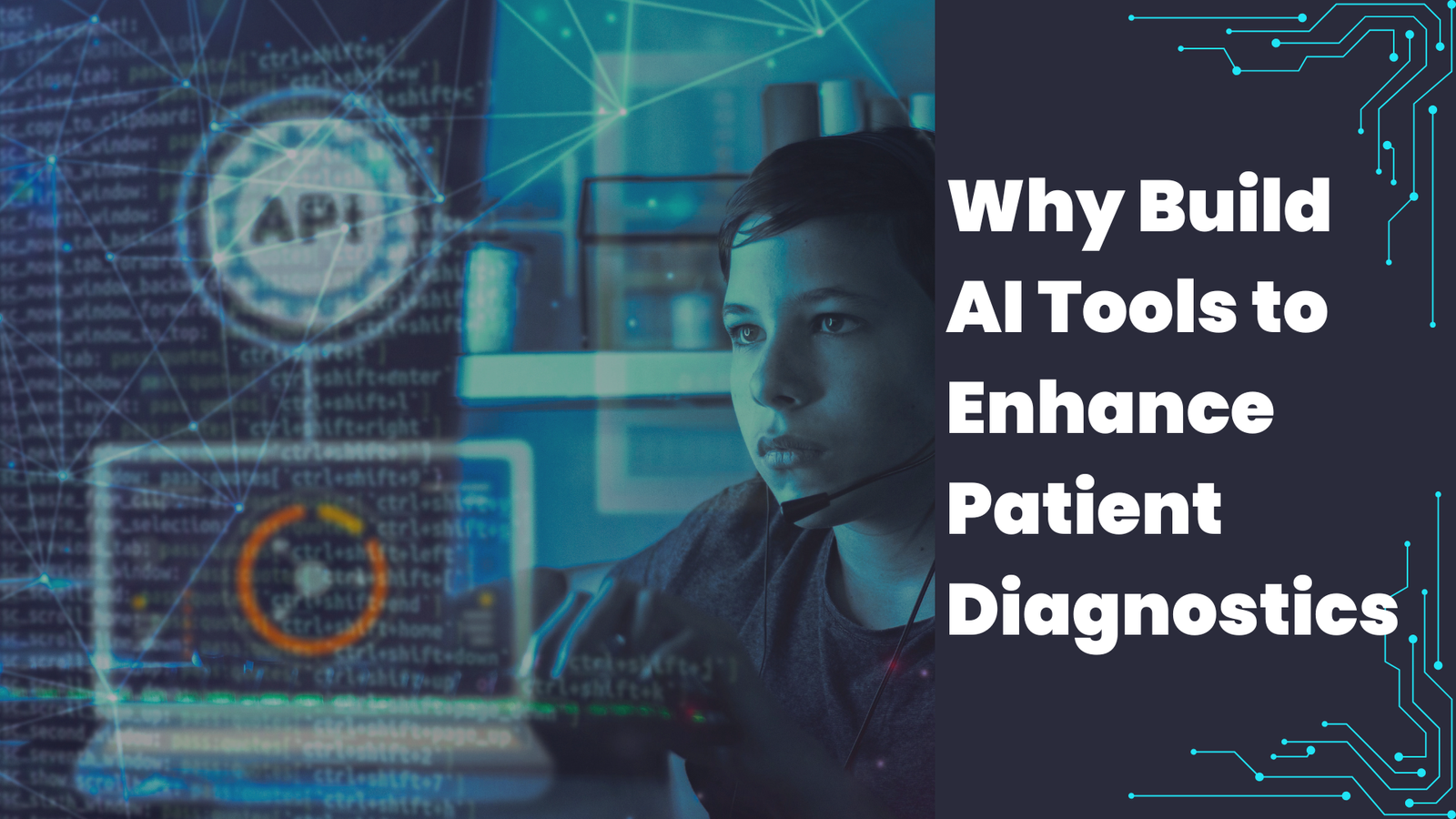In modern healthcare, diagnostics is both the foundation and the frontier. Everything from treatment decisions to patient outcomes depends on how accurately and how quickly diseases are identified. Yet, even with advances in medical imaging, laboratory testing, and electronic health records, diagnostics remains one of the most resource-intensive and error-prone areas of medicine.
Artificial intelligence (AI) has emerged as a force reshaping diagnostics with unprecedented speed. AI-powered tools now analyze radiology scans, pathology slides, lab reports, and even genomic data to deliver faster, more precise insights. But the question that matters most for healthcare systems, technology providers, and patients is: why build AI tools for diagnostics instead of simply refining existing methods?
The answer lies not in incremental improvements but in transformation—redefining how medicine detects, predicts, and personalizes care at scale. Let’s investigate why building AI tools to enhance patient diagnostics is not just an option but an imperative.
The Diagnostic Dilemma
Every healthcare system struggles with similar challenges:
- Rising Demand: Aging populations and chronic diseases are swelling the number of patients requiring complex diagnostics.
- Workforce Shortages: Radiologists, pathologists, and diagnostic specialists are in short supply worldwide.
- Data Explosion: Medical imaging and genomic data are growing at a rate far beyond human capacity to analyze.
- Error Rates: Studies suggest diagnostic errors affect millions of patients annually, with significant consequences for outcomes and costs.
Traditional systems simply can’t scale fast enough. AI tools, however, thrive under these conditions—processing data at massive scale, highlighting anomalies, and supporting clinical judgment.
Why AI Is Uniquely Suited for Diagnostics
Diagnostics requires spotting patterns and interpreting subtle signals. AI, trained on large datasets, is built for precisely this kind of work. Its advantages include:
- Speed: AI can analyze thousands of images or lab results in seconds.
- Consistency: Unlike humans, algorithms don’t fatigue or suffer from cognitive bias.
- Pattern Recognition: Deep learning models detect signals too subtle for the human eye.
- Predictive Power: AI doesn’t just identify current conditions—it predicts likely future risks.
These capabilities make AI more than just an assistant; they make it a force multiplier for clinicians.
Key Areas Where AI Enhances Diagnostics
1. Medical Imaging
Radiology is ground zero for AI in diagnostics. Deep learning algorithms interpret X-rays, CT scans, MRIs, and ultrasounds with accuracy that often rivals radiologists. For instance, AI can detect lung nodules, fractures, or tumors early, reducing missed diagnoses.
2. Pathology
Pathologists face a growing workload as cancer cases rise globally. AI tools can analyze digital pathology slides, flagging suspicious areas for closer review. This reduces time to diagnosis and supports early detection.
3. Genomics and Precision Medicine
AI processes genomic sequences rapidly, identifying mutations and predicting disease predisposition. This enables personalized treatment plans tailored to each patient’s biology.
4. Laboratory Testing
AI platforms interpret blood tests, biopsy reports, and molecular assays. By cross-referencing with patient history, they deliver more accurate diagnoses while reducing false positives and negatives.
5. Predictive Diagnostics
By analyzing EHR data, wearables, and lifestyle information, AI predicts the likelihood of conditions such as diabetes, cardiovascular disease, or sepsis before symptoms fully emerge. Early intervention saves costs and lives.
Why Build Instead of Buy?
The healthcare industry often debates whether to adopt off-the-shelf AI tools or build custom platforms. Building bespoke AI tools offers clear advantages:
- Tailored to Specific Needs: A cardiology department may require AI tuned to echocardiograms, while oncology demands tumor-focused algorithms.
- Control Over Data and Compliance: Custom solutions ensure patient data remains secure and compliant with HIPAA, GDPR, and other frameworks.
- Integration with Existing Systems: Built AI tools can be designed to slot seamlessly into existing EHRs and workflows.
- Continuous Improvement: Custom tools evolve alongside institutional data, becoming smarter over time.
For large healthcare organizations, building isn’t just about efficiency—it’s about owning the intelligence that drives clinical decisions.
The Development Roadmap for AI Diagnostic Tools
Building AI diagnostic tools is a meticulous process. Here’s how it unfolds:
Step 1: Define the Diagnostic Problem
Is the goal to identify cancers in pathology slides, detect arrhythmias in ECGs, or forecast patient readmission risks? Clear scope prevents wasted investment and ensures measurable impact.
Step 2: Data Collection and Preparation
Data is king. Hospitals must collect diverse, high-quality datasets—imaging scans, pathology slides, lab results, patient histories. Data cleaning, labeling, and anonymization are critical steps.
Step 3: Model Selection
Depending on the problem:
- CNNs (Convolutional Neural Networks) for image recognition.
- NLP models for analyzing text in medical reports.
- Hybrid models for combining structured and unstructured data.
Step 4: Training and Validation
Models are trained on labeled datasets, validated against separate samples, and refined iteratively. Metrics like sensitivity, specificity, and AUC (Area Under Curve) determine reliability.
Step 5: Clinical Testing and Trials
AI tools must undergo clinical validation. This means real-world testing alongside clinicians, ensuring safety, effectiveness, and usability.
Step 6: Integration with Workflows
AI tools must embed into diagnostic systems without disruption. Seamless integration into PACS, LIS, or EHR platforms is vital for adoption.
Step 7: Monitoring and Continuous Learning
Once deployed, AI must be monitored for drift—changes in performance as medical data evolves. Regular retraining ensures accuracy remains high.
Ethical and Regulatory Dimensions
AI diagnostics is powerful but sensitive. Ethical and legal safeguards are non-negotiable:
- Bias and Fairness: Algorithms must be trained on diverse datasets to avoid disadvantaging specific demographics.
- Explainability: Clinicians and patients must understand how an AI arrived at its conclusion.
- Compliance: Regulatory approvals (FDA, EMA, MHRA) are essential before tools can be widely deployed.
- Patient Consent: Patients should have clarity on how their data is used in training AI models.
Building AI responsibly is just as important as building it effectively.
Case Studies of AI in Diagnostics
- Google DeepMind: Developed AI that detects over 50 eye diseases from retinal scans with specialist-level accuracy.
- PathAI: Partners with pathologists to improve cancer diagnosis accuracy and reduce variability.
- IDx-DR: The first FDA-approved AI diagnostic tool for diabetic retinopathy.
- Zebra Medical Vision: Offers AI solutions for detecting bone health issues and cardiovascular problems from imaging.
These examples prove the viability and urgency of AI in diagnostics.
Barriers to Building AI Diagnostic Tools
Despite potential, hurdles remain:
- Data Silos: Patient data is fragmented across systems.
- High Costs: Development, validation, and compliance demand significant investment.
- Interoperability: Legacy systems often resist integration.
- Resistance to Change: Clinicians may distrust AI without adequate training and transparency.
Acknowledging these barriers is key to overcoming them.
The Economic Case for AI Diagnostics
Why should healthcare systems invest? Because the economics are compelling:
- Reduced diagnostic errors prevent costly malpractice claims.
- Faster diagnostics reduce hospital stays and resource strain.
- Predictive diagnostics lower treatment costs by catching conditions earlier.
- Operational efficiency frees up specialists’ time for complex cases.
AI isn’t just a medical innovation—it’s a financial strategy.
The Future of Diagnostics with AI
The road ahead points to:
- Federated Learning: AI trained across institutions without centralizing sensitive data.
- Multimodal Diagnostics: Combining imaging, genomic, and lab data for holistic insights.
- Edge AI in Devices: Wearables analyzing patient data in real time for early alerts.
- Personalized Diagnostics: AI tailoring diagnostic interpretations based on individual patient profiles.
The future diagnostic system won’t just detect disease; it will predict and prevent it.
The Human-AI Partnership
AI doesn’t replace clinicians; it extends their reach. A radiologist supported by AI can read more scans accurately. A pathologist can spend less time reviewing normal slides and more time on complex cases. Physicians can make decisions armed with evidence, not just intuition.
The real story is collaboration—AI handles the scale and speed, while humans bring empathy, ethics, and judgment. Together, they create smarter diagnostics.
Conclusion: Intelligence at the Core of Care
Building AI tools for patient diagnostics is about more than efficiency. It’s about addressing shortages in specialists, reducing errors, and delivering faster, more personalized care. It transforms diagnostics from a reactive process into a proactive, predictive engine of healthcare.
For organizations ready to embrace this future, the challenge is not whether to adopt AI, but how to build it responsibly, effectively, and sustainably. And in that journey, partnering with the right AI software development company ensures the expertise, compliance knowledge, and technical depth to bring smarter diagnostics from vision to reality.


